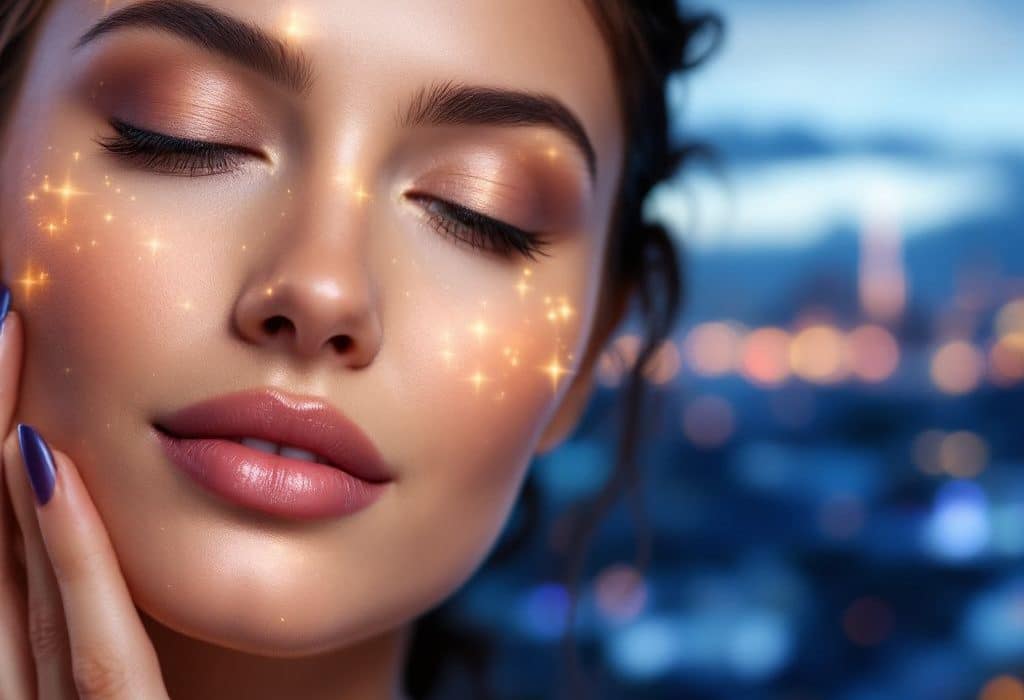Imagine wrapping your day up, cozy in your PJs, knowing that you’ve just taken the most crucial step towards healthier skin by applying a night cream. But what makes this routine specifically important for your skin? Stick around, as we’re about to dive deep into the science and artistry behind night creams, how they impact the skin, and why they can be a game-changer for your nighttime regimen.
Welcome to an exploration where we not only detail what makes night and facial creams essential but also arm you with actionable tips and fascinating insights drawn from clinical research.
The Magic of Night Cream: Understanding the Basics 🌙
The Skin’s Night Shift
Your skin, the body’s largest organ, is constantly working to protect, regenerate, and cleanse itself. At night, while the rest of your body rests, your skin ramps up its regeneration process. Research suggests that skin cell renewal is significantly more active at night, particularly between midnight and 4 a.m. This is why night creams are formulated differently from daytime products—they complement your skin’s reparative processes during these hours. For an in-depth understanding of how to optimize your nighttime routine, explore our best night moisturizer guide.
Differences Between Day and Night Cream
A day cream is often lightweight, providing hydration while also offering protection—look for added SPFs to block UV rays. In contrast, night face creams are typically thicker, containing ingredients that boost repair and healing without needing to shield against environmental stressors. The idea is to let the skin benefit from potent active ingredients without the interference of external pressures such as sun and pollution. For instance, indoor lighting can accelerate aging, which reinforces the need for effective nighttime skincare.
Key Ingredients That Make Night Creams Effective 🌿
Retinoids: The Gold Standard

Retinoids, derivatives of Vitamin A, are a staple in effective night creams. Clinically proven to increase cell turnover and boost collagen production, they help reduce fine lines and improve skin tone. Prescription-strength retinoids like tretinoin have been extensively studied and shown to significantly alter the skin’s structure, yielding more youthful, glowing skin. However, over-the-counter retinol can also be beneficial, albeit with a gentler touch. Curious about starting retinol early? Discover why using retinol in your 20s can be a proactive step.
**Tip:** Start with a lower concentration of retinoid to allow your skin to adapt, reducing the potential for irritation.
Hyaluronic Acid: The Moisture Magnet 💧
Hyaluronic acid is known for its incredible ability to retain moisture—up to 1,000 times its weight in water. This makes it a cornerstone ingredient in many facial creams, offering deep hydration that helps maintain a plump, youthful appearance. Its humectant properties make it ideal for preventing dryness, a key concern at night when damping moisture loss is beneficial. Explore how glycosaminoglycans enhance skin hydration and their role in maintaining skin health.
Peptides: The Building Blocks
Peptides are short chains of amino acids that serve as the building blocks of proteins like collagen and elastin. Used in night face creams, they signal the skin to repair itself and produce more collagen—a protein responsible for skin elasticity and firmness. Studies indicate that peptides can gradually lead to skin strengthening and improvement, lending a more lifted, toned appearance over time. To learn more about addressing mature skin needs, visit our detailed guide on mature skin care.
Antioxidants: The Skin Protectors 🛡
Ingredients like Vitamin E, Vitamin C, and green tea extract act as antioxidants to combat oxidative stress caused by free radicals. This oxidative damage can accelerate aging, making antioxidants vital in night creams for supporting and maximizing the skin’s repair functions. Discover more about the effects of environmental factors like humidity on aging and how antioxidants can mitigate these impacts.
**Example:** Try using a night cream that combines Vitamin C with E and ferulic acid for enhanced antioxidant stability and performance.

Practical Application: How to Maximize Night Cream Benefits
Step-by-Step Guide to Getting it Right
**1. Cleanse Thoroughly:** Start with a gentle cleanser to ensure your skin is clean and primed for the active ingredients in your night cream.
**2. Apply Actives Like Retinoids or Acids:** If using retinoids or alpha hydroxy acids (AHAs), use them before your moisturizer for maximum penetration. Be cautious not to mix strong actives that might cause irritation.
**3. Seal with Night Cream:** Gently apply your night face cream, massaging upwards—this helps with absorption and boosts blood flow.
**4. Hydration Top-up:** Consider a final layer of simple, pure moisturizer if your skin is particularly dry.
Longevity Tips
- Patch Test: Before including new ingredients in your nighttime routine, like potent retinoids or exfoliants, it’s wise to patch test and proceed gradually.
- Consistency Pays Off: Results won’t happen overnight, especially with anti-aging goals. Be consistent over months to see significant improvement.
- Don’t Overload on Actives: Stick to formulations you know are compatible and avoid layering multiple potent actives together.
The Science Behind Sleep and Skincare
Sleep: The Unsung Hero
While targeting skincare concerns disseminate a significant impact, integrating healthy sleep hygiene is indispensable. During quality sleep, you’ve bathed your body in melatonin—a hormone known for its regenerative properties. Studies suggest that insufficient sleep accelerates skin aging, underlining why pairing good skin care with adequate sleep forms a powerful duo.
Skin Cycle Synchronization
Remember that peak regeneration coincides with nighttime application, making targeted night care especially effective. Utilizing products that fit this rhythmic cycle fortifies natural processes, offering enhanced skin conditioning. For a comprehensive solution to mature skin concerns, explore our anti-aging solutions for mature skin.
Avoiding Common Night Cream Pitfalls

“Do this, not that” Examples
- Do: Use a dime-sized amount; too much can overwhelm the skin.
- Don’t: Skip other aspects of nighttime hygiene; heavy creams require a balanced regimen.
- Do: Store face creams in a cool dry place for maximum shelf life.
- Don’t: Combine all new products at once; integrate slowly to determine individual effectiveness.
Mistakes to Dodge
- Skipping Sunscreen in the AM: Active ingredients like retinoids increase photosensitivity—don’t forget SPF protection the next day.
- Ignoring Skin pH: Over-cleansing can strip the skin’s acid mantle. Balance with a pH-appropriate cleanser to support barrier function.
- Dark Spots Concern: For those dealing with pigmentation issues, consider reading about overnight solutions for black spots.
- Forehead Spots: If you struggle with pigmentation specifically on the forehead, learn how to effectively target these spots.
Steps Toward Advanced Facial Creams: Testing and Results 📊
Exploring formulations often involves trials. Brands invest in both clinical studies recruiting real users and in-vitro testing, evaluating cellular response under controlled conditions. For insight into effective dark spot treatments, consider how specific serums can help remove dark spots and improve skin clarity.
Case Study Snapshot
For example, a night cream comprising microencapsulated retinol and Vitamin C showed marked improvements in skin tone and fine lines after 12 weeks when applied nightly, as assessed through user feedback and dermatologist evaluation. 😊
Conclusion: Embrace the Night Cream’s Potential
Night creams harbor a unique opportunity for targeted skincare by aligning with the body’s natural reparative processes. Incorporating clinically substantial actives into your nighttime routine heralds visible, tangible benefits, especially under a holistic umbrella that champions good sleep, a balanced routine, and consistent sun protection.
A well-chosen night cream can act as your silent ally; embracing it ensures that every gentle application propels you toward the skin simplicity, health, and luminosity you inherently deserve. Through practical application and informed choice, let your nighttime ritual become a testament to the empowerment of skincare intelligence.
Bookmark this guide, return as you refine your routine, and witness the efficacy of a correctly applied night face cream transform not only your regimen but forge robust pathways towards enduring skin health. 🌟
Frequently Asked Questions
What are the benefits of using a hair mask in my hair care routine?
Using a hair mask can provide several benefits, including hydration, smoothing, strengthening, curl definition, heat protection, and damage repair. Hair masks infuse the hair with moisture, help coat the hair shaft to seal split ends, reduce breakage, and protect the hair from heat styling and environmental damage[1][4].
What ingredients should I look for in a hair mask?
Effective hair masks often include ingredients such as coconut oil, argan oil, shea butter, honey, avocado oil, green tea, and coconut water. These ingredients provide nourishment, moisturize, and protect the hair, offering benefits like softening, moisturizing, and protecting against damage[2][5].
How often should I use a hair mask in my routine?
You should use a hair mask whenever your hair feels dry, unmanageable, or in need of intense hydration. This can vary depending on your hair type and needs, but generally, using a hair mask once or twice a week can help maintain healthy and moisturized hair[1][4].
How do I apply a hair mask for the best results?
To apply a hair mask effectively, shampoo your hair first, then apply the mask, focusing especially on the ends where hair tends to be the most damaged. Leave the mask on for anywhere from 10 minutes to overnight, depending on the type of mask and your hair’s needs[1][4].
References



